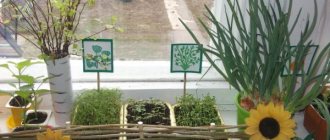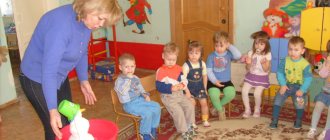Environmental project “Good Mood Corner”
Ecological project
"Good Mood Corner"
Updating the problem.
In our difficult life, we so often lack a good mood. Based on the children’s survey, as well as mini-essays on the topic “Beautiful Injustice”, written under the motto “What shocked me most,” together with the children we decided to create a living corner. After all, our children are kind, sensitive, dreaming of being useful, caring for someone, striving to participate in new activities where they show themselves well.
Objectives of the study
- Learn to work with various sources of information;
- Develop cognitive activity, intellectual and creative abilities, initiative, independence;
- Develop an emotional and aesthetic attitude towards nature and image objects;
- Develop communication skills (work in a creative group);
Research objectives
- Study the living conditions of plants and animals indoors;
- Investigate the environmental factors of the premises;
- Identify the most popular plants and pets in school gardening;
- Identify the centers of origin of popular indoor plants;
- Study the rules and methods of placing plants and animals indoors.
Research methods
- Collecting information on indoor plants and animals from various sources: fiction, scientific and popular science literature, studying the results of activities.
Modeling the placement of indoor plants and animals taking into account the rules of phytodesign.
- Methods of theoretical research (inductive and deductive methods).
Basic expert groups
Statisticians Ecologists Geographers Phytodesigners Zoologists
Project content
I.
_
Organizational stage STATISTICS
- Study the species composition of the school's indoor plants.
- Determine which plants are most often used for landscaping school premises.
- Present the research results in graphical form.
- Conduct a promotional campaign among school students and residents of the neighborhood
Geographers
- Place business cards of popular indoor plants and the most popular representatives of the living area on a map of the natural areas of the continents.
- Study theoretical materials on the characteristics of land biomes.
- Determine how plants are adapted to exist in certain natural conditions.
- Draw a conclusion about the origin of the main groups of popular indoor plants.
Ecologists
- Set the orientation of the room windows to the sides of the horizon.
- Using various instruments, study the complex of abiotic environmental factors that determine the conditions for the existence of plants indoors. Determine: temperature, air humidity, lighting intensity. Present research results in table form
II. Project implementation
With tatista
- Production of advertising leaflets and carrying out advertising campaigns.
- Processing the results of the survey and presenting them in the form of a diagram. Making a wall newspaper “Living Corner of Good Mood”.
Progress of the study
Geographers and zoologists
1. Carrying out research work using the method of A.I. Savenkov on the topic “Indoor plants and inhabitants of a living corner.” 2. Let's write a fairy tale! "A Tale about a Living Daredevil's Tenant." 3. Let's write a letter! A letter to the inhabitants of the living corner “Grow Healthily.”
Phytodesigners
- Operation “Living corner in the apartment” Interaction with communities: kindergarten No. 57, secondary school No. 40, secondary school No. 24
- Meeting with the designer
- Independent preparation of phytodesign projects
Ecologists
- Care and observation of plants and animals.
- Excursion to the ostrich farm “Visiting Baba Frosya.”
- Studying the living conditions of plants, rules and methods of placing them indoors.
- Conducting experiments
Introduction to fiction
- Familiarization with works of popular science and fiction with an environmental focus.
- Visiting city libraries “Writers and poets visiting nature”
- Reading legends, fairy tales, poems, riddles about medicinal plants.
Drawing:
- Development of graphic skills and creative thinking.
- “Our friends are houseplants”, “My little friend”, “Who, who lives in the house?”
- Exhibition of drawings “Magic plants”, “Together a friendly family”
- Decorative drawing
Application:
Development of graphic skills and creative thinking.
“Our friends are green friends”, “My little friend”, “Who, who lives in the house?”
Exhibition of drawings “Amazing Friends”, “More Fun Together”
III. Summarizing
Conclusions of zoologists
- The most common representatives of the living corner: among birds - the budgie, among rodents - guinea pig, hamster, among reptiles - turtle;
- We studied the species composition of each group, origin, living conditions, and maintenance features of the inhabitants of the living area;
- Monitored the correct maintenance of the inhabitants of the living area in a school environment in accordance with generally accepted standards.
Conclusions of phytodesigners
- You can transform the room in which you work or relax into an oasis, where beauty and comfort reign, where the harmony of nature and man reigns, if you correctly place individual plants or entire compositions.
- Basic rules of phytodesign: color harmony, correct selection of dishes, reliability of fastenings of flower beds and flowerpots; in large rooms, free-standing plants or compositions of tall plants are used; for small rooms, vertical compositions of small plants are preferred.
Geographers' conclusions
- Most indoor plants come from tropical, subtropical and desert regions.
- When growing indoor plants, it is necessary to take into account the biological characteristics formed under the influence of the natural and climatic conditions of their places of origin.
- Conclusions of ecologists
- The living conditions for plants in the biology classroom of MBOU “Secondary School No. 12” are favorable, since the complex of abiotic environmental factors (illumination, humidity, temperature) meets the standards.
- We recommend using more medicinal plants in landscaping (aloe, kalanchoe, basil) and “living conditioner” - chlorophytum crested
Conclusions of statisticians
- In indoor landscaping, plants belonging to five groups are used: decorative deciduous, beautifully flowering, ampelous, climbing, and bulbous.
- The most popular plants in MBOU "Secondary School No. 12" are: chlorophytum, nephrolepis, begonias, syngonium, hibiscus, monstera, aspidistra, sansevieria.
- In schools, it is best to grow simple, undemanding plants that bloom easily and abundantly, reproduce easily, and can be cared for by children.
Project progress report. Project protection.
Conclusions on the project
- When placing indoor plants, it is necessary to comply with the plants' requirements for lighting, temperature and humidity conditions, and also take into account biological characteristics formed under the influence of natural and climatic conditions.
- The complex of environmental factors in a living area is favorable for the existence of many indoor plants.
- The most popular in landscaping are chlorophytum crested, ferns, begonias, syngonium, and Chinese hibiscus. Children are engaged in business with interest after school. in a living corner.
- The appearance of smiles on the faces of people visiting the living area.
"School of Friendship and Kindness"
Game “Who Gave Kind Words?”
Goal: harmonization of relationships in children’s communication, teaching the ability to show kind feelings towards another person.
Age: 4–7 years.
Description Children stand in a circle. A driver is selected, sits on a chair in the center of the circle and closes his eyes. Participants in the game walk in a circle saying:
Here the game will begin now, The rain of kind words will fall. Guess who came up and gave kind words.
The child, whom the psychologist (or teacher) touches with his hand, approaches the driver and, touching him gently, gives kind words. For example, “Petya, you are caring, smart and kind.” The driver must recognize by the voice the one who gave the kind words. If the driver recognizes the player, the game continues with a new driver.
Game "Adults and Children"
This game is often used by practical psychologists (unfortunately, I cannot indicate the author). It has improved the part with the “magic” hand massage that children perform, as well as the final part of the game.
Goal: development of imagination, creation of goodwill and mutual understanding in children’s communication with each other.
Age: 5–7 years.
Description The group is divided into two subgroups: the first is “children”, the second is “adults”. “Children” sit on chairs placed in a circle. “Adults” stand behind the seated “children.” Before starting the game, they stroke and knead their hands, turning them into the gentle, kind hands of loved ones. A psychologist can show children how a “magic” hand massage is performed and accompany the actions with the words:
I will stroke my hands, Be kind little hands, To caress and gently stroke My little children.
After this, the “adults” begin to gently stroke the shoulders and arms of the “children.” After a few seconds, the “adults” change their charges. After 2–3 shifts, the “children” in their care determine: a) which “adult” is the most affectionate and gentle; b) with whose hands can the hands of an “adult” be compared: mother, father, grandfather, grandmother.
Then the “children” and “adults” change roles.
Game "School of Friendship"
Goal: children’s awareness of the value of friendly relationships in communicating with people.
Age: 5–7 years.
Description Children stand in a circle. All of them are students at the School of Friendship. An adult offers children cards with pictures of family members (mom, dad, grandmother, grandfather, brother, sister). Psychologist (or teacher):
Be careful, look: There is a family member in the picture. What can you do to become a reliable friend?
Each child takes turns telling what he can do for this or that person to become his friend.
You can also use photographs of group children and kindergarten teachers.
Comment: all games can be used in work with children by both psychologists and kindergarten teachers and parents of preschoolers.
Tatiana SHIROKOVA teacher-psychologist, MBDOU Kindergarten No. 17, Kirovo-Chepetsk, Kirov region
Corner of psychological relief
| The problem of preserving and strengthening the psychological health of preschool children is obvious. We live in an era of crises and social change. The economic and value instability of society has a negative impact on our preschoolers. This is confirmed by children with disorders of psycho-emotional development, who express emotions of anger with aggression, who do not know how to negotiate, who have difficulty adapting to life in a children’s group, who do not respect their friend, his feelings, mood and emotions. Based on the above, the problem of preserving not only the physical, but also the psychological health of preschool children and the formation of their emotional well-being is of particular importance. It is very important to teach preschoolers to accept themselves as they really are - a sign of mental health and an indicator of personal growth. After all, self-acceptance largely determines the nature of interaction with other people. To solve this problem, it is necessary to create appropriate conditions and organize the subject environment. For this purpose, our group created a “Psychological Relief Corner”. |
Goal : direct – unity, creation of warmth and comfort, an emotionally comfortable environment.
Indirect is a place for play.
Of particular interest is comfort.
Safety – transparent material, soft pillows, toys.
A corner of solitude will help you calm down, relax, “hide” from the hustle and bustle, “call mom,” play quiet games and favorite toys, look at a family album, interesting books, sitting on a lot of pillows.
There is a corner in our group
He's not low, he's not high
The kids are resting there
They lift the mood.
Pleasant music and a glowing lamp calm and relax.
Box - myrilka . The children join hands inside it and say the words of the peace song:
Make up, make up and don't fight anymore.
These are beautiful balls
Multi-colored skeins
Let's just take them in our hands
And we’ll start rolling soon.
Reconciliation pillow in the shape of a candy . Taking the “candy” in their hands, the children smile and say kind, affectionate words to each other.
Scream cups . Help relieve tension.
Rug of anger. The child takes off his shoes and wipes his feet on it until his mood improves.
To increase the self-esteem of anxious, insecure children - medals.
Mood board . On it, the child can choose a magnet that matches his
Toys, pillows filled with cereal. You can rub them with your hands and calm down.
"Bags of Moods" If a child is in a bad mood, he can put it in a “sad” bag, and “take” a good mood from a “cheerful” bag.
Magic items: hats, cloak, magic wand, magic slippers. They will help your child make a wonderful journey and turn into a fairy-tale hero by doing good deeds.
"Dry pool" of beans. Helps children relieve psychological stress.
"Twister". A game for teaching children cooperation and coordinated teamwork.
Middle group teachers: Ionina N.N., Cherepanova L.A.





